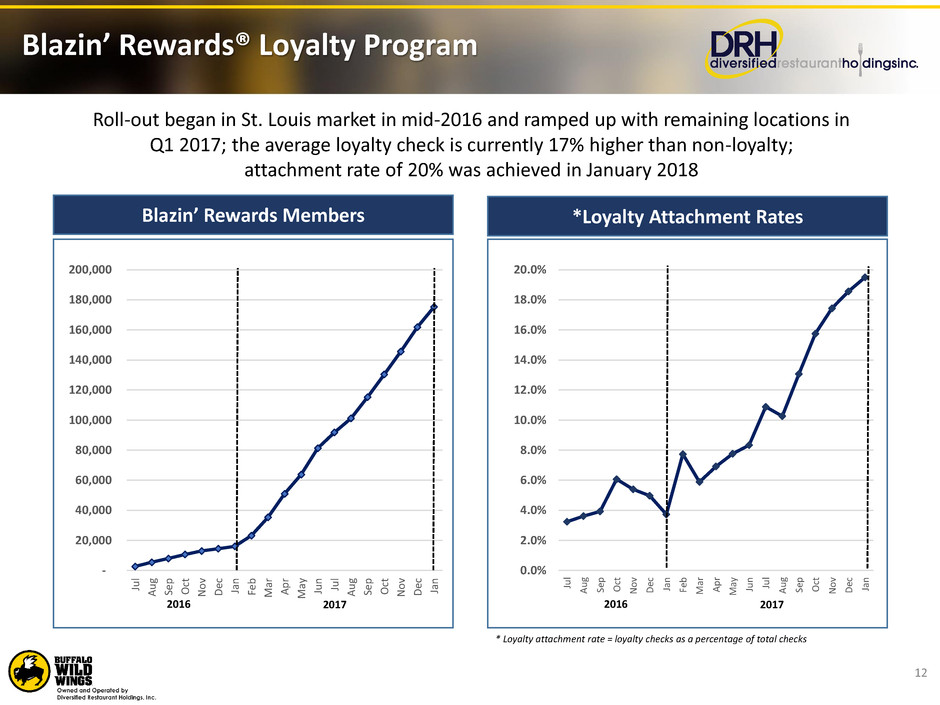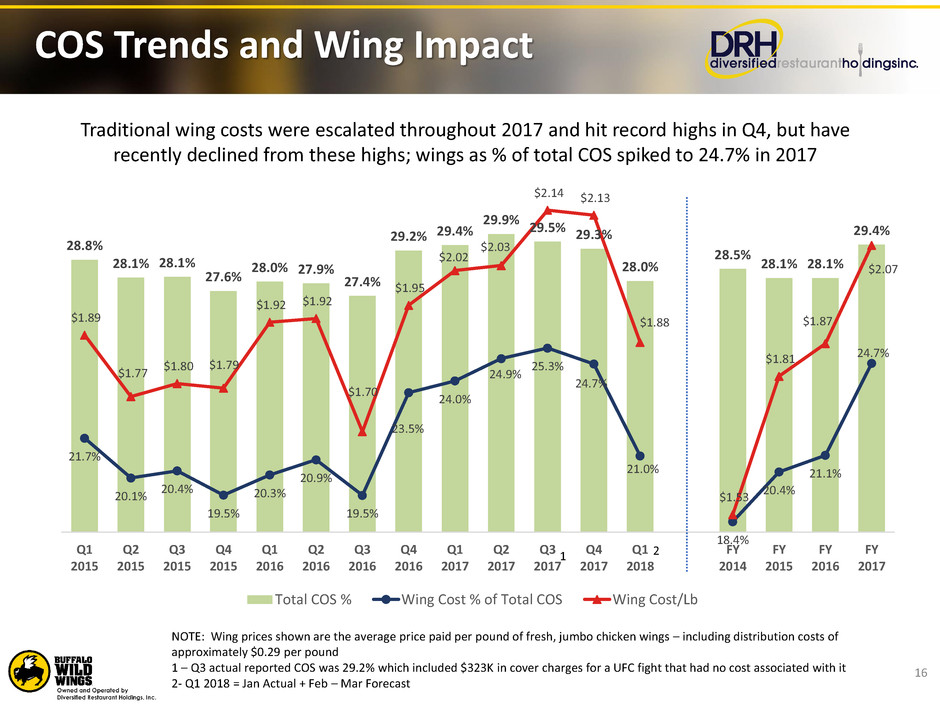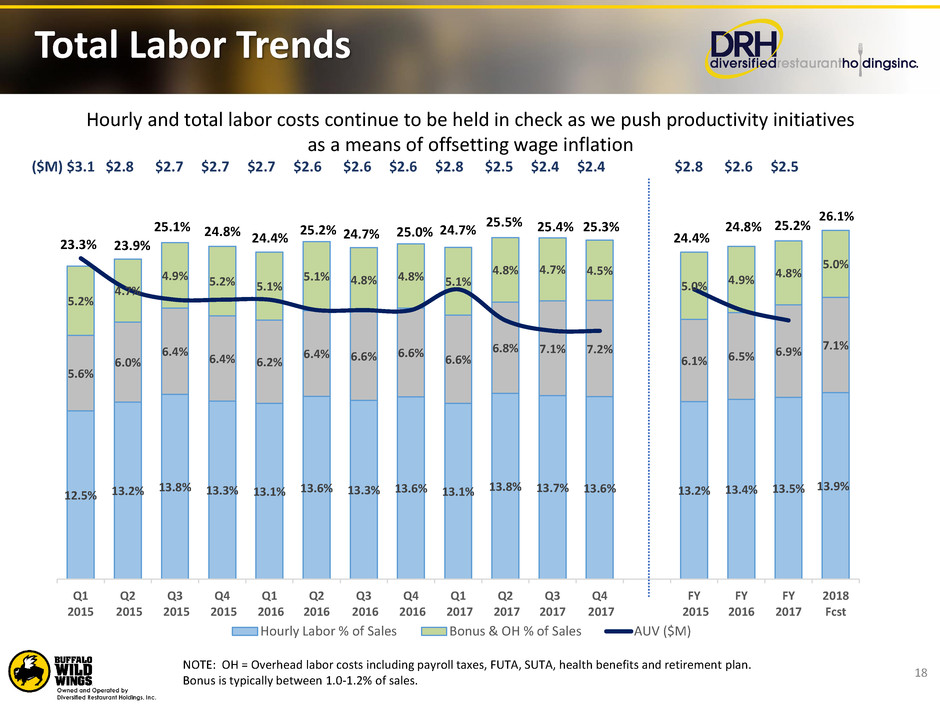Attached files
| file | filename |
|---|---|
| EX-99.1 - EXHIBIT 99.1 - Diversified Restaurant Holdings, Inc. | a991saucq42017earningsrele.htm |
| 8-K - 8-K - Diversified Restaurant Holdings, Inc. | a8-kearningsreleaseq42017.htm |

Q4 and FY 2017 Financial Results
March 9, 2018

Safe Harbor
2
The information made available in this presentation contains forward-looking statements which
reflect the Company’s current view of future events, results of operations, cash flows,
performance, business prospects and opportunities. Wherever used, the words "anticipate,"
"believe," "expect," "intend," "plan," "project," "will continue," "will likely result," "may," and
similar expressions identify forward-looking statements as such term is defined in the Securities
Exchange Act of 1934. Any such forward-looking statements are subject to risks and
uncertainties and the Company's actual growth, results of operations, financial condition, cash
flows, performance, business prospects and opportunities could differ materially from historical
results or current expectations. Some of these risks include, without limitation, the impact of
economic and industry conditions, competition, food and drug safety issues, store expansion and
remodeling, labor relations issues, costs of providing employee benefits, regulatory matters,
legal and administrative proceedings, information technology, security, severe weather, natural
disasters, accounting matters, other risk factors relating to our business or industry and other
risks detailed from time to time in the Securities and Exchange Commission filings of DRH.
Forward-looking statements contained herein speak only as of the date made and, thus, DRH
undertakes no obligation to update or publicly announce the revision of any of the forward-
looking statements contained herein to reflect new information, future events, developments or
changed circumstances or for any other reason.

Who We Are
NASDAQ: SAUC
IPO: 2008
Market capitalization $40M
Largest Buffalo Wild Wings Franchisee
› Leading operator
› Strong cash generator
› 65 BWW locations
› Recent share price $1.49
› 52 week range $1.30 - $4.12
› Insider ownership 50%
› Institutional ownership 17%
› Shares outstanding 26.7M
3
Pure play franchisee with scale and track record of accretive acquisitions
Market data as of March 6, 2018 (Source: S&P Capital IQ); Ownership as of most recent filing

2017 Key Information
Sales of $165.5M, down 0.6% vs. last year
Negative impact from Hurricane Irma and revenue deferral related to new loyalty program and
overall reduced traffic, partially offset by addition of 53rd week in 2017
Same Store Sales off 3.7%
Adjusted EBITDA of $19.9M, 12.0% of sales
Restaurant-level EBITDA of $28.3M, 17.1% of sales
Strong Free Cash Flow of $8.6M
Net cash from operations of $12.7M, down from $17.0M in 2016; FCF improved $3.6M on reduced cap ex
Cost of sales up 134 basis points vs. 2016, as wing prices were high throughout most of the year
Margin down 2 pts. vs. 2016 as a result of record high food costs through most of 2017
Slower traffic across the system throughout much of 2017, particularly the fourth quarter
4
Sales
S-S-S
EBITDA
Margins
Cashflow

Adjusted EBITDA Bridge
5
Cost of sales, driven by record high chicken wing prices, accounted for over 65% of the year-over-year
decline in EBITDA, followed by the impact of slower traffic and Hurricane Irma closures; operating
expenses were held in check despite the sales headwinds
* Other includes: Occupancy ($0.4M) driven by NROs, Other Opex ($0.3M) driven by delivery expense, Compensation ($0.6M)
driven by minimum wage increases and management labor
$18.5 $18.5 $19.4
$19.9
$2.0
$2.9
$1.4
$23.3
$1.5
$0.9
$0.5
FY 2016
Adj. EBITDA
53rd Week
Impact
Sales
Impact
COS (Traditional
Wings)
*Other Restaurant Level
Initiatives
G&A Reductions FY 2017
Adj. EBITDA

EBITDA Headwinds – Outlook
Headwinds: 2017 Current Outlook
Sales
▪ Promotion driven, value seeking consumer
without cohesive brand strategy
▪ Major shift in brand media strategy results in
significant negative trend departure from
CD industry in H2 2017
▪ NFL viewership down
▪ New approach under changed
ownership – proven track record
• Media, promotion, food and
beverage strategy
▪ Seasoning of loyalty program
Cost of sales ▪ Record high wing prices weigh down margins ▪ Wing market has corrected
6
Corrective Action: 2017 Current Outlook
Labor
▪ Offset labor inflation and sales deleveraging
with labor productivity improvements ▪ Savings and productivity
initiatives will carry over into the
future
▪ We should benefit from leverage
of sales lift going forward
Operating Expenses
▪ Tight management of operating expenses to
offset sales deleveraging
General &
Administrative
▪ Labor reduction
▪ Expense reduction
▪ Sales and COS pressure offset by productivity and savings initiatives, coupled with tight capex management
▪ Net EBITDA impact applied tension to bank covenants – negotiated significant covenant relief for 8 quarters
allowing DRH to maintain existing debt amortization schedule and low interest rates

Sales and Traffic
7

Average Check and Traffic Trends
8
NOTE: Average check is predominantly driven by price, but is also influenced by product mix and, to a lesser extent, average guests per check.
1 – Ramping up of Tuesday Promotion and the Bogo Blitz offering in 2016 drove 170 bp of the 12.3% traffic decline in Q4 2017.
2.6% 2.9%
5.5% 5.9%
7.7%
4.1%
1.3% 0.8%
-2.2% -2.7% -1.8%
-5.4%
-0.3%
-3.7%
-4.4%
-6.8%
4.3% 3.0%
-3.1%
-3.7%
0.9% 1.1%
2.2%
0.2%
0.6%
-2.5%
-1.8% -2.0% -2.0%
-3.0%
-3.3%
-4.3%
2.0%
-1.9%
-6.3%
-12.3%
1.1%
-3.0%
-3.2%
-4.8%
1.7% 1.7% 3.3%
5.7%
7.1%
6.6%
3.1% 2.8%
-0.2%
0.2%
1.4%
-1.1%
-2.3%
-1.8%
1.9%
5.5%
3.2%
6.1%
0.1%
1.1%
Q1
2014
Q2
2014
Q3
2014
Q4
2014
Q1
2015
Q2
2015
Q3
2015
Q4
2015
Q1
2016
Q2
2016
Q3
2016
Q4
2016
Q1
2017
Q2
2017
Q3
2017
Q4
2017
FY
2014
FY
2015
FY
2016
FY
2017
SSS%
Traffic %
Avg Check %
1
Traffic was a major issue in both Q3 and Q4, partially due to promotional shifts away from
Half Price Tuesdays; Stronger average check reflects pricing and improved penetration of the
Blazin’ Rewards loyalty program

Relative SSS Performance – FY 2017
9
Our regional footprint drives the difference in FY 2017 SSS relative to
preliminary FY 2017 results reported by BWLD
BWW same store sales were negative across all regions of the United States in 2017
▪ Nearly a third of DRH restaurants are located in the weakest region (Florida)
▪ The remaining DRH restaurants are located in the moderate performing regions (Plains/Midwest)
▪ Over 40% of BWLD locations are located in the strongest regions of the United States
Distribution of Locations and
BWW Relative SSS Performance by Region
Heat Map of BWW
Regional Relative SSS Performance
Sources: BWLD 2016 10-K and 2018 8-K; DRH data
Note: Distribution data based on 2016 YE portfolios for BWLD and BWLD Franchisees, for illustrative purposes. Excludes international.
BWLD Relative
Region Performance BWLD DRH
West/SW 30% 0%
Southeast 14% 0%
Midwest 27% 49%
Plains 9% 23%
NE/Mid-Atlantic 18% 0%
Florida 3% 28%
Weak SSS % 43% 0%
Weaker SSS% 36% 72%
Weakest SSS% 21% 28%
FY2017 SSS% -1.7% -3.7%
Distribution of Locations by Region
West/Southwest
Plains
Midwest
Southeast
Better Worse

Sales Bridge ($M)
10
Q4 and FY 2017 sales were favorably impacted by the 53rd week, increases in average ticket, and
NRO’s, offset by negative traffic, particularly in the fourth quarter
*FY 2017 Other includes: Unfavorable number of major sporting events ($0.8M), impact of Hurricane Irma ($0.6M), major construction projects ($0.4M).
$41.9
$0.1
$5.3
$40.8
$3.7
$2.1
$0.7
Q4 2016
Revenue
53rd Week Avg Ticket NRO Loyalty
Deferred Rev
Traffic/Other Q4 2017
Revenue
Q4 2016 vs. Q4 2017 FY 2016 vs. FY 2017
$165.4
$165.4
$0.4
$8.2
$166.5
$3.7
$2.3
$1.5
FY 2016
Revenue
53rd Week Avg Ticket NROs Loyalty
Deferred Rev
*Traffic/
Other
FY 2017
Revenue

Delivery
11
Delivery and Carry-Out Sales as % of Total
The delivery channel continues to show growth, while carry-out as a percentage of total sales
declined, largely due to the impact of promotional changes in late-Q3 and Q4 2017
Delivery Drives Incremental Sales
▪ 38 locations now offer delivery service through
third parties (up from 26 last year)
▪ 2017 delivery sales increased $1.3M to $2.0M
over 2016 and are expected to reach approx.
$2.4M in 2018
▪ Average delivery check is 13% higher than
dine-in and 17% higher than carry-out
20.6%
19.3% 19.5%
20.4%
21.9% 21.4%
20.2%
19.1%
1.9%
2.7% 2.8% 3.1% 2.7% 3.0%
Q1 2016 Q2 2016 Q3 2016 Q4 2016 Q1 2017 Q2 2017 Q3 2017 Q4 2017
% of Carry-Out Sales % of Delivery Sales

Blazin’ Rewards® Loyalty Program
12
Blazin’ Rewards Members
Roll-out began in St. Louis market in mid-2016 and ramped up with remaining locations in
Q1 2017; the average loyalty check is currently 17% higher than non-loyalty;
attachment rate of 20% was achieved in January 2018
*Loyalty Attachment Rates
* Loyalty attachment rate = loyalty checks as a percentage of total checks
0.0%
2.0%
4.0%
6.0%
8.0%
10.0%
12.0%
14.0%
16.0%
18.0%
20.0%
Ju
l
A
u
g
Se
p
O
ct
N
o
v
D
ec Ja
n
Fe
b
M
ar
A
p
r
M
ay Ju
n
Ju
l
A
u
g
Se
p
O
ct
N
o
v
D
ec Ja
n
2016 2017
-
20,000
40,000
60,000
80,000
100,000
120,000
140,000
160,000
180,000
200,000
Ju
l
A
u
g
Se
p
O
ct
N
o
v
D
ec Ja
n
Fe
b
Ma
r
A
p
r
Ma
y
Ju
n
Ju
l
A
u
g
Se
p
O
ct
N
o
v
D
ec Ja
n
2016 2017

Margins and EBITDA
13

Quarterly Restaurant EBITDA Trends
14
1 – On June 29, 2015, we acquired 18 locations in the St. Louis market to add to our existing 44 units, which had a dilutive AUV of $2.3 million
2 – FF = Franchise-related fees which includes 5.0% royalty and 3.0 – 3.15% NAF (national advertising fund)
Record high chicken wing prices coupled with sales deleveraging placed added pressure on recent margins
AUV ($M) $3.1 $2.8 $2.7 $2.7 $2.7 $2.6 $2.6 $2.6 $2.8 $2.5 $2.4 $2.4 2.8 $2.8 $2.6 $2.5
21.8% 20.6% 19.4% 20.3% 21.5% 20.0% 19.6% 16.5% 19.0% 16.6% 15.9% 17.1%
21.2% 20.4% 19.4% 17.1%
5.5% 5.9% 6.4% 6.6%
6.5% 6.8% 7.0%
7.2%
6.5%
7.1% 7.6% 7.2%
5.2% 6.2% 6.8%
7.1%
8.0% 8.0% 8.0% 8.0%
8.2% 8.1% 8.1%
8.1%
8.0%
8.1% 8.2% 8.1%
8.0% 8.0% 8.1%
8.1%
12.6% 13.4% 13.0% 12.7%
11.5% 12.1% 13.3%
14.0% 12.3% 12.9% 13.8% 13.1%
13.2% 12.9% 12.7%
12.9%
23.3% 23.9% 25.1% 24.8% 24.4% 25.2% 24.7% 25.0% 24.7% 25.5% 25.4% 25.3%
23.8% 24.4% 24.8%
25.2%
28.8% 28.1% 28.1% 27.6% 28.0% 27.9% 27.4% 29.2% 29.4% 29.9% 29.2% 29.3% 28.5% 28.1% 28.1% 29.4%
0
0.5
1
1.5
2
2.5
3
3.5
KEY Q1
2015
Q2
2015
Q3
2015
Q4
2015
Q1
2016
Q2
2016
Q3
2016
Q4
2016
Q1
2017
Q2
2017
Q3
2017
Q4
2017
FY
2014
FY
2015
FY
2016
FY
2017
AUV ($M)
C
O
S
LA
B
O
R
OPE
X
FF2
OCC
R
ES
T.
EB
IT
D
A
11

Cost of Sales Bridge
15
Historically high traditional chicken wing costs and lower wing yields, coupled with the Tuesday
wing promotions, were responsible for a 137 bp increase in cost of sales in 2017 vs. 2016
29.44%
0.03%
28.10%
1.37%
FY 2016
COS %
Traditional Wings Food/Beverage/Other FY 2017
COS %

COS Trends and Wing Impact
16
NOTE: Wing prices shown are the average price paid per pound of fresh, jumbo chicken wings – including distribution costs of
approximately $0.29 per pound
1 – Q3 actual reported COS was 29.2% which included $323K in cover charges for a UFC fight that had no cost associated with it
2- Q1 2018 = Jan Actual + Feb –Mar Forecast
Traditional wing costs were escalated throughout 2017 and hit record highs in Q4, but have
recently declined from these highs; wings as % of total COS spiked to 24.7% in 2017
28.8%
28.1% 28.1%
27.6%
28.0% 27.9%
27.4%
29.2% 29.4%
29.9%
29.5% 29.3%
28.0%
28.5%
28.1% 28.1%
29.4%
21.7%
20.1%
20.4%
19.5%
20.3%
20.9%
19.5%
23.5%
24.0%
24.9%
25.3%
24.7%
21.0%
18.4%
20.4%
21.1%
24.7%
$1.89
$1.77
$1.80 $1.79
$1.92 $1.92
$1.70
$1.95
$2.02
$2.03
$2.14 $2.13
$1.88
$1.53
$1.81
$1.87
$2.07
Q1
2015
Q2
2015
Q3
2015
Q4
2015
Q1
2016
Q2
2016
Q3
2016
Q4
2016
Q1
2017
Q2
2017
Q3
2017
Q4
2017
Q1
2018
FY
2014
FY
2015
FY
2016
FY
2017
Total COS % Wing Cost % of Total COS Wing Cost/Lb
21

Historical Wing Prices
17
$ / lb. Fresh Jumbo Northeast Chicken Wing Spot Prices
Source: Urner Barry Comtell™ UB Chicken – Northeast Jumbo Wings
NOTE: Logistics cost to restaurants is $0.29 / lb. over the spot price
Volatile fresh wing spot prices had ranged between $1.41 and $2.16/lb. since 2015;
prices have been on the decline since October 2017, with the spot price currently at $1.35

Total Labor Trends
18
NOTE: OH = Overhead labor costs including payroll taxes, FUTA, SUTA, health benefits and retirement plan.
Bonus is typically between 1.0-1.2% of sales.
Hourly and total labor costs continue to be held in check as we push productivity initiatives
as a means of offsetting wage inflation
($M) $3.1 $2.8 $2.7 $2.7 $2.7 $2.6 $2.6 $2.6 $2.8 $2.5 $2.4 $2.4 $2.8 $2.6 $2.5
12.5% 13.2%
13.8% 13.3% 13.1% 13.6% 13.3% 13.6% 13.1% 13.8% 13.7% 13.6% 13.2% 13.4% 13.5% 13.9%
5.6%
6.0%
6.4%
6.4% 6.2%
6.4% 6.6% 6.6% 6.6%
6.8% 7.1% 7.2%
6.1% 6.5%
6.9% 7.1%
5.2%
4.7%
4.9% 5.2% 5.1%
5.1% 4.8% 4.8% 5.1%
4.8% 4.7% 4.5%
5.0% 4.9%
4.8%
5.0%
Q1
2015
Q2
2015
Q3
2015
Q4
2015
Q1
2016
Q2
2016
Q3
2016
Q4
2016
Q1
2017
Q2
2017
Q3
2017
Q4
2017
FY
2015
FY
2016
FY
2017
2018
Fcst
Hourly Labor % of Sales Bonus & OH % of Sales AUV ($M)
23.9%
25.1% 24.8% 24.4%
25.2% 24.7% 25.0% 24.7%
25.5% 25.4% 25.3%
24.4%
24.8% 25.2%
26.1%
23.3%

G&A Run Rate Trending Down
19
G&A costs continue to trend down as cost savings initiatives take effect;
nearing our target of 5% of sales, despite lower than anticipated sales
$7.9 $7.6
$7.2
$1.0
$0.8
$0.7
5.4%
5.1%
5.0%
5.0%
5.1%
5.1%
5.2%
5.2%
5.3%
5.3%
5.4%
5.4%
$-
$1.0
$2.0
$3.0
$4.0
$5.0
$6.0
$7.0
$8.0
$9.0
$10.0
FY2016 FY 2017 2018 Fcst
G&A $ Marketing $ Total G&A % of Sales

Adjusted EBITDA Trends
20
21.8%
20.6%
19.4% 20.3%
21.5%
20.0% 19.6%
16.5%
19.0%
16.6% 15.9%
17.1%
21.2% 20.4% 19.4%
17.1%
4.3%
8.0%
5.8%
5.1%
4.9%
5.3% 5.7%
5.6%
5.1%
5.0% 4.9%
5.3%
5.1%
5.7% 5.4%
5.1%
1
1.5
2
2.5
3
Key Q1
2015
Q2
2015
Q3
2015
Q4
2015
Q1
2016
Q2
2016
Q3
2016
Q4
2016
Q1
2017
Q2
2017
Q3
2017
Q4
2017
FY
2014
FY
2015
FY
2016
FY
2017
AUV ($M)
G
&
A
R
ES
T.
EB
IT
D
A
AUV ($M) $3.1 $2.8 $2.7 $2.7 $2.7 $2.6 $2.6 $2.6 $2.8 $2.5 $2.4 $2.4 $2.8 $2.8 $2.6 $2.5
G&A expenses have been reduced, partially offsetting the impact of lower
store-level margins driven by higher cost of sales and lower overall sales

Exhibits
21

Free Cash Flow and Net Debt
22
2015 2016 2017
Total net sales 144.8$ 166.5$ 165.5$
Restaurant level EBITDA 29.7$ 32.3$ 28.3$
Adjusted EBITDA 21.6$ 23.3$ 19.9$
Capital expenditures (20.2)$ (12.5)$ (4.7)$
Changes in net working capital 3.9$ 0.0$ 0.0$
Interest (4.2)$ (5.8)$ (6.6)$
Taxes -$ -$ -$
Free cash flow 1.1$ 5.0$ 8.6$
Scheduled debt amortization (8.2)$ (10.0)$ (12.1)$
Cash 14.2$ 4.0$ 4.4$
Debt 126.3$ 121.2$ 113.9$
Net debt 112.1$ 117.2$ 109.5$
Net debt / EBITDA 5.2X 5.0X 5.5X
($ millions)

EBITDA Reconciliation
23

EBITDA Reconciliation cont.
24
Restaurant-Level EBITDA represents net income (loss) plus the sum of non-restaurant specific general and administrative expenses, restaurant pre-
opening costs, loss on property and equipment disposals, depreciation and amortization, other income and expenses, interest, taxes, and non-recurring
expenses related to acquisitions, equity offerings or other non-recurring expenses. Adjusted EBITDA represents net income (loss) plus the sum of
restaurant pre-opening costs, loss on property and equipment disposals, depreciation and amortization, other income and expenses, interest, taxes, and
non-recurring expenses. We are presenting Restaurant-Level EBITDA and Adjusted EBITDA, which are not presented in accordance with GAAP, because
we believe they provide an additional metric by which to evaluate our operations. When considered together with our GAAP results and the reconciliation to
our net income, we believe they provide a more complete understanding of our business than could be obtained absent this disclosure. We use
Restaurant-Level EBITDA and Adjusted EBITDA together with financial measures prepared in accordance with GAAP, such as revenue, income from
operations, net income, and cash flows from operations, to assess our historical and prospective operating performance and to enhance the understanding
of our core operating performance. Restaurant-Level EBITDA and Adjusted EBITDA are presented because: (i) we believe they are useful measures for
investors to assess the operating performance of our business without the effect of non-cash depreciation and amortization expenses; (ii) we believe
investors will find these measures useful in assessing our ability to service or incur indebtedness; and (iii) they are used internally as benchmarks to
evaluate our operating performance or compare our performance to that of our competitors.
Additionally, we present Restaurant-Level EBITDA because it excludes the impact of general and administrative expenses and restaurant pre-opening
costs, which is non-recurring. The use of Restaurant-Level EBITDA thereby enables us and our investors to compare our operating performance between
periods and to compare our operating performance to the performance of our competitors. The measure is also widely used within the restaurant industry
to evaluate restaurant level productivity, efficiency, and performance. The use of Restaurant-Level EBITDA and Adjusted EBITDA as performance
measures permits a comparative assessment of our operating performance relative to our performance based on GAAP results, while isolating the effects
of some items that vary from period to period without any correlation to core operating performance or that vary widely among similar companies.
Companies within our industry exhibit significant variations with respect to capital structure and cost of capital (which affect interest expense and tax rates)
and differences in book depreciation of property and equipment (which affect relative depreciation expense), including significant differences in the
depreciable lives of similar assets among various companies. Our management team believes that Restaurant-Level EBITDA and Adjusted EBITDA
facilitate company-to-company comparisons within our industry by eliminating some of the foregoing variations.
Restaurant-Level EBITDA and Adjusted EBITDA are not determined in accordance with GAAP and should not be considered in isolation or as an
alternative to net income, income from operations, net cash provided by operating, investing, or financing activities, or other financial statement data
presented as indicators of financial performance or liquidity, each as presented in accordance with GAAP. Neither Restaurant-Level EBITDA nor Adjusted
EBITDA should be considered as a measure of discretionary cash available to us to invest in the growth of our business. Restaurant-Level EBITDA and
Adjusted EBITDA as presented may not be comparable to other similarly titled measures of other companies and our presentation of Restaurant-Level
EBITDA and Adjusted EBITDA should not be construed as an inference that our future results will be unaffected by unusual items. Our management
recognizes that Restaurant-Level EBITDA and Adjusted EBITDA have limitations as analytical financial measures.
